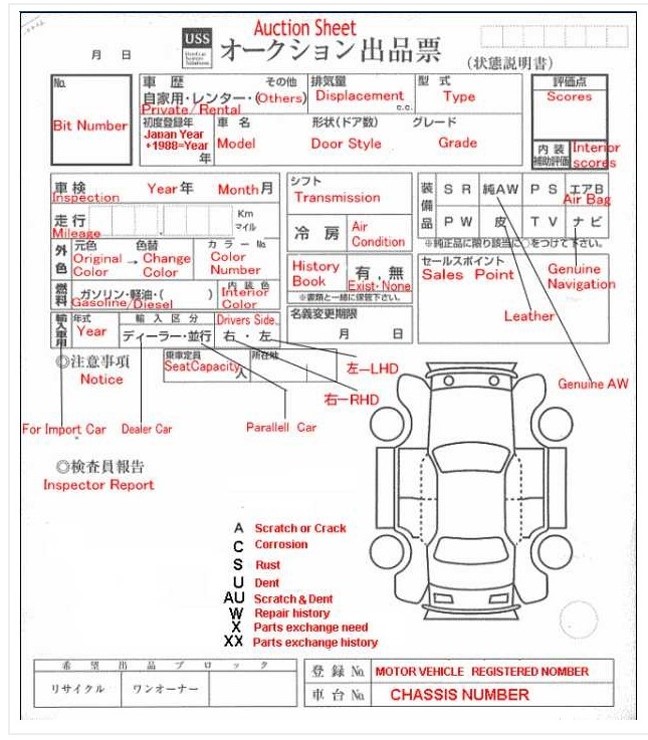
| Overall Grades |
| 6 |
New |
| 5 |
As good as new with no flaws |
| 4.5 |
Very clean, one panel affected by minor paint blemish |
| 4 |
More than one panel affected by minor paint blemishes |
| 3.5 |
Some attention to panel and paint is required |
| 3 |
Rough overall condition |
| 2 |
Serious panel damage, rusty or water damages |
| 1 |
Significant performance upgrades or mechanical changes |
| A, 0, R |
Accident damage and repair |
| Interior Grades |
| A |
As good as new with no condition faults |
| B |
Very clean and nice |
| C |
Average / Clean for age including expected wear and tear |
| D |
Cigarette burns / smell, rips, tears, or other damages to interior |
| Option Codes |
| SR |
Sunroof |
| AW |
Alloy Wheels |
| PS |
Power Steering |
| PW |
Power Windows |
| AB |
Airbag |
| Vehicle Diagram |
| XX |
Panels have been replaced
due to repairs and / or painted. |
| W |
Wavy
Can mean the affected panel has been painted, and the paint is not as smooth as the original factory paint. However, in some cases even when marked with a W it is impossible to tell with the naked eye whether paintwork has been done. Auction staff can make mistakes also, and mark panels W when they are uncertain. W or W1, W2 and W3 are used, with 1 being least noticeable. |
| A |
Scratch
A1 is a tiny scratch, and generally you would expect this to buff out or be an easy touch up. A2 is a medium scratch through the top layer of paint, and won't easily be hidden. A3 is a deep scratch such as a serious scrape or intentional key mark, and will definitely require paintwork if you want to fully address it. |
| U |
Pin dent
Only a small dent such as you would pick up in the carpark. U1 to U4 are used to denote the size of the dent, with 1 being the smallest. |
| B |
Larger dents
These are more serious than pin dents. They are quite noticeable dents and range from B1 to B4. |
| G |
Chip
You might see a G, X or even an A marked on the windscreen. This usually indicates a small stone chip or scratch and often these are quite small, the size of a pin head or so, and not easily visible. They are the sort of things most cars pick up through normal use and if you see them noted it doesn't mean the windscreen needs replacing. |
| Y |
Cracks
Y1 to Y4. Usually in bodykits or lights and often not a major issue as repair or replacement is fairly simple. |
| P |
Paint Damage
P1 to P4. Fading, scratches or discolouration from sun damage, polishing, peeling, crazing or poor paintwork. |
| S/C |
Rust / Corrosion
S and C1 to C4 are generally used. An S or C1 on the body can mean a small stone chip has some surface rust or there is a spot of rust on the edge of a sunroof which might be easily addressed. In other cases S noted in the negative comments section could indicate extensive underbody rust. C indicated on the wheel arches is a sign there is serious corrosion due to use in snowy areas. Physical inspections are undertaken for rust regardless of whether it is noted on the Japanese auction sheet, as even grade 4.5 vehicles can be rusty. |
Grading reports or Japanese auction sheets are used to list the details of the vehicle and its condition.
Reporting formats varies depending on the auction house that it was listed on, but generally the basic information remains the same.
Numeric values from 0 to 6 (6 being the best) are used to determine the overall grade, while A to D grades (A being the best) the interior condition of the vehicle. Sometimes, an additional A to D grade is included for the vehicle's body condition. EG: 5 A A
Interiors graded A should be virtually as new. B is also considered extremely clean, and C is often used for average condition.
For some auctions a C is still very good, while at others it will mean the interior is dirty, has cigarette burns, or obvious wear and tear. C for a vehicle older than 10 years is generally expected, but would be cause for concern on a 2-year old vehicle.
D usually means very untidy, dirty, smoke-affected, or stripped out for racing.



